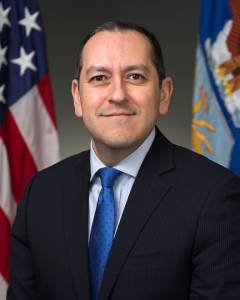Air Force creates new office to crunch human capital data
The Air Force is standing up a new human capital analytics office, hoping to make better use of the data it already has in order to help solve ongoing recruiting...
The Air Force is standing up a new human capital analytics office, hoping to make better use of the data it already has in order to help solve ongoing recruiting and retention challenges.
The new cell — based within the office of the assistant secretary for manpower and reserve affairs — will initially operate as a two-year pilot program, staffed by a small team of data experts partnered with personnel experts from the office of the undersecretary of Defense for personnel and readiness.

“There’s pockets of analytic capability that are within the Air Force today, but I envision this office as being the connective tissue to link up the recuriters and the personnel community with all of the folks that provide complex analytic information on the manpower side throughout the department,” Gabe Camarillo, the assistant secretary of the Air Force for manpower and reserve affairs said during a wide-ranging interview for On DoD with Jared Serbu. “The goal is that in the long term it’ll be a critical resource for helping us manage the talent that we need.”
As to new accessions, Camarillo said officials believe better analytics could help identify untapped sources of talent throughout the country and give the Air Force access to future military members and government civilians who aren’t targeted by current recruiting practices.
“Our recruiting service is, proportionally, the smallest in the Department of Defense. We have to do more with fewer resources because we have fewer people who can be present in communities, so with data analytics, we think we can do microtargeting of communities where we think we can attract talent that we don’t attract today,” he said.
On retention, Camarillo said better data analytics could, for example, help the Air Force identify more effective incentives to help stop an ongoing exodus of pilots to the private sector.
“We’ve already done a lot in the area of retention surveys to begin to address that challenge, so my question is how can data analytics help us in the future to identify trends, retention challenges, opportunities, even before they become a major challenge for us? I want to be predictive from a talent management perspective.”
One of the office’s first tasks will be to begin improving the Air Force’s ability to aggregate and analyze manpower data that’s stored in incompatible, relatively inaccessible formats across various, purpose-built legacy IT systems. A similar DoD-wide effort is now underway as part of the Office of People Analytics established earlier this year by Defense Secretary Ashton Carter.
“They’re working with resources like the Defense Manpower Data Center and other treasure troves of human capital data to see how we might be able to scratch the surface in terms of spotting trends that help us manage talent,” Camarillo said. “That’s one of the challenges we face up front — part of it’s technical, part of it’s institutional, but we have to start to take those steps now to help us prepare for the future.”
The Air Force created the office in late September as one of 13 separate diversity and inclusion initiatives announced by Air Force Secretary Deborah Lee James. Other elements in the broader project include requiring more female and minority representation on Air Force command selection boards, giving female airmen more time to decide whether to stay in the Air Force after they become pregnant, adding more professional development programs for Air Force civilians and encouraging minorities to join career fields in which they’re currently underrepresented, such as pilots, air battle management, combat systems and cyber and intelligence operations.
The 13 initiatives are a follow-on to nine other diversity and inclusion programs James announced last year, and Camarillo said the Air Force intends to use the new analytics office to help measure the extent to which they’re serving their stated purposes of adding more diverse perspectives to the service’s talent pool and increasing innovation.
“We want to see how all of these initiatives are performing,” he said. “We’ve seen some signs of success from the 2015 initiatives, but we want to monitor the data not only to inform how well we’re doing on current policy but what might work best in the future.”
Copyright © 2025 Federal News Network. All rights reserved. This website is not intended for users located within the European Economic Area.
Jared Serbu is deputy editor of Federal News Network and reports on the Defense Department’s contracting, legislative, workforce and IT issues.
Follow @jserbuWFED





